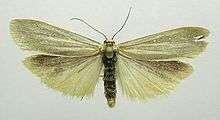Manulea pygmaeola
| Pigmy footman | |
|---|---|
 | |
| Scientific classification | |
| Kingdom: | Animalia |
| Clade: | Euarthropoda |
| Class: | Insecta |
| Order: | Lepidoptera |
| Superfamily: | Noctuoidea |
| Family: | Erebidae |
| Genus: | Manulea |
| Species: | M. pygmaeola |
| Binomial name | |
| Manulea pygmaeola | |
| Synonyms | |
| |
Manulea pygmaeola, the pigmy footman, is a moth of the family Erebidae. It is found in the western half of the Palearctic ecozone, east to Altai.
The wingspan is 24–28 mm. There is one generation per year with adults on wing from June to August.
The larvae feed on various lichen species on rocks and wooden poles. Larvae are found from August to June. The species overwinters in the larval stage.
Subspecies
- Manulea pygmaeola pygmaeola
- Manulea pygmaeola banghaasi (Seitz, 1910) (Asia Minor, Transcaucasia)
- Manulea pygmaeola pallifrons (Zeller, 1847) (north-western Africa, Europe, Crimea, Caucasus)
- Manulea pygmaeola saerdabense (Daniel, 1939) (western Kopet Dagh, northern Iran, Mountains of eastern Central Asia)
References
- ↑ Dubatolov, V. V. & V. V. Zolotuhin. (2011). Does Eilema Hübner, (1819) (Lepidoptera, Arctiidae, Lithosiinae) present one or several genera? Euroasian Entomological Journal 10(3) 367-79, 380, col. plate VII.
External links
| Wikimedia Commons has media related to Eilema pygmaeola. |
| Wikispecies has information related to Manulea pygmaeola |
- Pigmy Footman (Eilema pygmaeola) on UKmoths
- Eilema pygmaeola on Fauna Europaea
- Eilema pygmaeola on Lepiforum.de
This article is issued from
Wikipedia.
The text is licensed under Creative Commons - Attribution - Sharealike.
Additional terms may apply for the media files.